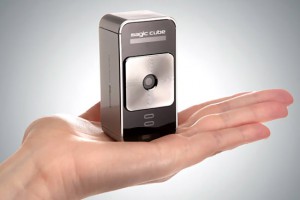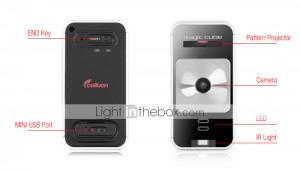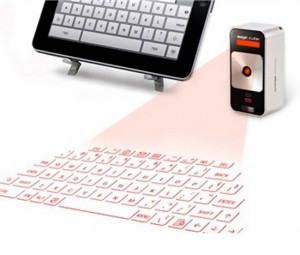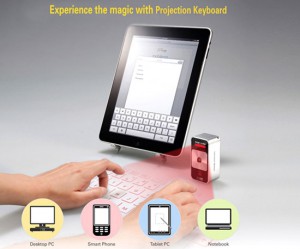The virtual keyboard, also known as the laser keyboard is made by Celluon. Celluon is a company that specializes in researching and making portable input applications using 3D electronic perception technology (EPT). The company headquarter base is in Seoul, Korea. This invention idea came into place because even though we are in a society with rapid technology developments, many people are still hindered by the lack of portability in traditional input applications such as the regular keyboard and foldable keyboard.
This tiny device uses laser to project a keyboard on any flat surface. You can then type away accompanied by simulated key click sounds. The Laser Virtual Keyboard can approach typing speeds of a standard keyboard and is the size of a matchbook. The detection technology based on optical recognition enables the user to tap the images of the keys, complete with realistic tapping sounds, which feed into the compatible Bluetooth-enabled PDA, Smartphone, laptop or PC. The virtual keyboard emits infrared light from the lower end of the product to detect objects such as fingers. When an object passes through the area illuminated by the infrared light source, any infrared light reflecting off the object is detected by the sensor. Information on the position and movement of the object is then analyzed to perform the product’s role as a keyboard.
Technology:
Template creation (Projection Module)
A template of the desired interface is projected onto the adjacent interface surface. The template is produced by illuminating a specially designed, highly efficient holographic optical element with a red diode laser. Note: the template serves only as a reference for the user and is not involved in the detection process. In a fixed environment, the template can just as easily be printed onto the interface surface.
Reference plane illumination (Micro-illumination ModuleTM)
An infra-red plane of light is generated just above, and parallel to, the interface surface. This light is invisible to the user and hovers a few millimeters above the surface. When the user touches a key position on the interface surface light is reflected from this plane in the vicinity of the key and directed towards the sensor module.
Map reflection coordinates (Sensor Module)
Reflected light from user interactions with the interface surface is passed through an infra-red filter and imaged on to a CMOS image sensor in the sensor module. Custom hardware embedded in the sensor chip (the Virtual Interface Processing CoreTM) then makes a real-time determination of the location of the reflected light. The processing core can track multiple reflection events simultaneously and can thus support both multiple keystrokes and overlapping cursor control inputs.
Interpretation and communication (Sensor Module)
The micro-controller in the sensor module receives the positional information corresponding to the light flashes from the sensor processing core, interprets the events (e.g. keydown, keyup, mouse or touchpad control etc..) and communicates them through an appropriate interface to external devices.
Below are some key points about this gadget. It actually looks pretty cool too.
- It Projects a full-size laser keyboard onto any flat surface
- Allows the convenience of full-size typing in a tiny form factor
- Connects wirelessly via Bluetooth to iPhone, iPad, many Smartphones and most Laptops
- Mouse mode allows you to use your finger as a mouse rather than typing when using with a laptop.
- Rechargeable battery lasts for 150 minutes of continuous typing
- Charges via USB.
- No drive to install
- The controller functions for the laser keyboard are very simple.
Below is a list of what is represented on the cube:
- End Keyboard
- Mini USB port
- Pattern projector
- Camera
- LED
- IR Light
Here’s the product specifications:
Keyboard Projection:
Light source Red diode laser
Keyboard layout 63 key / full sized QWERTY layout
Keyboard size 295 x 95mm projected keyboard size
Keyboard position 60mm from VKB unit
Required Projection surface Non-reflective, opaque flat surface
Visibility Good contrast up to 600 lux ambient illumination
Keyboard Sensor:
Ambient illumination Works under all standard indoor illuminations up to 600 lux
Detection Rate Up to 400 characters per minute
Detection algorithm Multiple keystroke support
Effective keystroke Approximately 2mm
Operating surface Non-reflective, opaque flat surface
Visibility Any firm flat surface with no protrusions greater than 1mm
Bluetooth:
Bluetooth Spec Bluetooth v1.1 class 2
Bluetooth Profile Supported HID and SPP
Range of Frequency 2.4 GHz Spectrum
Transmission range 9m
Number of supported passkeys 5
Electrical:
Power Source Integrade, 3.6V rechargeable lithium-ion battery
Battery Capacity >120 minutes continuous typing
Charge Method Included 100-240V AC Wall Adapter
Dimensions:
Approximately 35 x 92 x 25mm (1.38″ x 3.6″ x 1″)
In conclusion, I think this product is pretty cool because of its small size for portable travel. It saves a lot of space on your table and we never have to worry about spilling liquids onto the keyboard and for the its price, it’s really not that bad.







